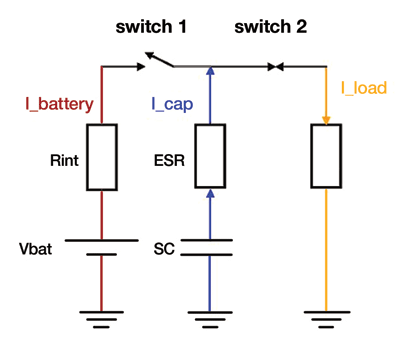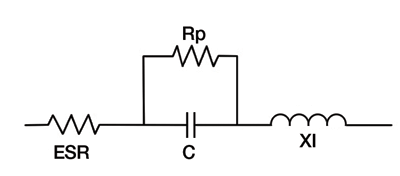Supercaps: Components with a split personality
Supercapacitors act as capacitors or batteries or as components extraordinaire
BY MARK GEBBIA
Director of Engineering, Illinois Capacitor
www.illcap.com
Are they capacitors or batteries? While supercapacitors are by design capacitors, their very high energy storage capability often places them in competition with batteries. In other situations, supercaps and batteries tag-team to do what neither could do alone.
While supercapacitors have been commercially available since the late 1970s, it is only recently that technology has been able to bring costs down while jacking up performance. Also called ultracapacitors and electric double layer capacitors (EDLC), these components offer capacitance values greater than any other capacitor technology available today. The upper limit seems to reach new heights every few months, with single standard case-size values in the 3,500-F range currently available. Most voltage ratings are in the 1.2 to 5.5-WVdc range, but like other capacitors, multiple components can be combined to create higher voltage modules.
Most engineers have a basic understanding of supercaps, but may not realize how affordable they have become in recent years. And, performance has improved with corresponding speed. It’s almost like watching a passive component version of Moore’s Law. Here’s an example of how costs have dropped. In 2007, one popular value supercap had an average market price of about $1.36. Since that time, the price has dropped by 80%.

The rapid decrease in price is driven the economies of scale and the use of high-volume, automated production machinery. Like in other areas of technology, raw material costs have not declined.
Big advantages
As in the Moore’s Law analogy, as the costs have gone down performance has improved even more dramatically. In 2007, Illinois Capacitor’s biggest value of supercapacitor was 220 F; and 400 F in 2008. We made the leap to 3,500 F in 2012. The latest supercapacitors have capacitive densities so high that they can be used for applications previously reserved for batteries. Supercaps will not displace batteries in most applications, as they are not as volumetrically efficient and are more expensive. But supercaps do have other advantages over batteries, making them a preferred choice in applications requiring a large amount of energy storage and delivered in repeated bursts. Advantages include:
• High-power density
• Rechargeable without degradation
• Lightweight
The most significant advantage supercapacitors have over rechargeable batteries is their ability to be repeatedly charged and discharged without losing performance. This is why batteries and supercapacitors are often used in conjunction with each other. A good example of such an application is solar-powered lighting. Over time, rechargeable batteries will lose their ability to fully charge from their daily solar cell recharging. The addition of a supercapacitor to supplement the battery can greatly extend its useful life. In this situation, the parallel-wired batteries supply the bulk energy, while the supercapacitors supply short pulses or energy bursts (which can degrade batteries). While probably not cost-effective for inexpensive consumer accent lights, this approach can make economic sense in commercial installations.
Battery types that pair well with supercaps include:
• Lithium thionyl chloride
• Lithium Manganese Dioxide
• Lithium Iodine
• Zinc air
• Zinc/ silver oxide
• Poly(carbon Monofloride-lithium)
Batteries and supercaps: Different and complementary
Batteries
• High energy density
• Long discharge time
• Cycles (
• HHigh cost, relative to lifespan
• Wide operating temperature range
• Subject to shipping regulations
Supercapacitors –
• >500,000 pulse cycles
• No maintenance (replacement)
• Standardized cases
• Low ESR
• High power density
• Non-polarized
• Fast charge/discharge
• Circuit board mountable
Because of their ability to quickly charge and deliver surges or energy bursts, supercaps are also a good fit for devices that generate pulses or data streams. Remotely monitored sensors that rely on energy harvesting and security strobe lighting are two such examples. In such installations, the supercap may be used solo or with a battery.
Portable and automotive music systems can see performance improvements with help from supercapacitors. Automotive batteries cannot keep up with the peak-power demands of high-end autosound systems and this may affect system performance.
Supercapacitors have found many other uses including a wide variety of energy storage and energy harvesting applications. In UPS systems, power conditioners, and power inverters, a couple of supercapacitors may replace a bank of conventional capacitors, reducing size and weight. The transportation industry has taken advantage of the energy storing characteristics of supercapacitors as a way to increase the performance of regenerative braking systems in commercial vehicles. One of the simplest and oldest applications is memory backup in personal computers and computer-based systems. While more expensive than batteries, supercapacitors do not need to be replaced over the lifespan of the product. This is especially useful for commercial capital equipment, where reliability is vital and the system has an expected lifetime of greater than 2 years. Illinois Capacitor and other manufacturers offer supercaps that even resemble the commonly used button batteries.
In battery-support applications, supercapacitors will supply power to the system in short energy bursts, while the batteries recharge the supercapacitors between the bursts. The batteries life can now be extended by a factor of 3 or more. The cost of the supercapacitor is offset by the savings found by not having to replace batteries.


Fig. 1: Here’s A simple example of how supercapacitors and batteries can work together. (a) Supercapacitor charging. (b) Supercapacitor delivering energy burst. In still other applications, like wind energy applications, supercapacitors can replace batteries in the wind turbine towers or be used as a supplement.
Similarities to electrolytic capacitors
Supercaps physical appearance and construction is pretty similar to that of aluminum electrolytics, but that’s where the similarity ends. Unlike conventional capacitors, energy is stored in a supercapacitor at the interface between a metal and the ionic electrolyte. A simplified explanation of how this works is that the electrolyte the charge is made of ions while in the conductor will have holes or electrons. To keep this system in balance or neutral the opposite charge is established on the other plate. This creates a double layer of charges, hence the name electric double layer.

Fig. 2: Unlike conventional capacitors that are made out of two metal electrodes, the electrolytes in a supercap are separated by a dielectric material.
Equivalent circuit
The equivalent circuit of supercapacitors can be illustrated in the same way as any other type of capacitor (see Fig. 3).

Fig. 3. The equivalent circuit of supercapacitors can be illustrated in the same way as any other type of capacitor.
Balancing act
In applications requiring the supercapacitors to be connected together in modules to meet capacitance and voltage requirements, the capacitor will need to be balanced. While simple in concept, this turns out to be much more complex task than just wiring the components together. It is important to recognize that unlike batteries, for example, capacitors can vary in value significantly, and still be within acceptable tolerance. With the variations in capacitance values, the voltage across an individual capacitor can exceed the voltage capabilities of the device. This can cause excessive heat to be generated within the capacitor and premature failure.
There are two common balancing methods used: passive and active. Passive balancing is an inexpensive solution involving resisters wired in parallel with the capacitors to equalize the voltage across the capacitors. Active balancing requires the use of ICs connected across the capacitors. The chip will monitor the network and applying changes as required. A number of semiconductor manufacturers offer chips for this application.
After the capacitor balancing is resolved, there are additional requirements in the development of a supercapacitor module. Physical requirements, internal connections, environmental requirements, and termination requirements all need to be addressed before a module can be designed and built. Based on the complexities in demands of a supercapacitor module, we recommend that module design and construction be performed in conjunction with your capacitor supplier.
While supercapacitors look and function in ways that makes them appear comparable to aluminum electrolytic capacitors, their technology and capabilities are dramatically different. In recent years, costs have come down much more rapid pace than other components. With energy storage capabilities reaching ever higher levels, engineers will to find new applications for supercapacitors. With an increasing variety of terminations and case sizes available supercapacitor uses will continue to expand, while they become even more cost effective. Illinois Capacitor offers a number of resources to learn more at www.illinoiscapacitor.com/tech-center/papers.aspx. ■
Advertisement
Learn more about Illinois Capacitor





